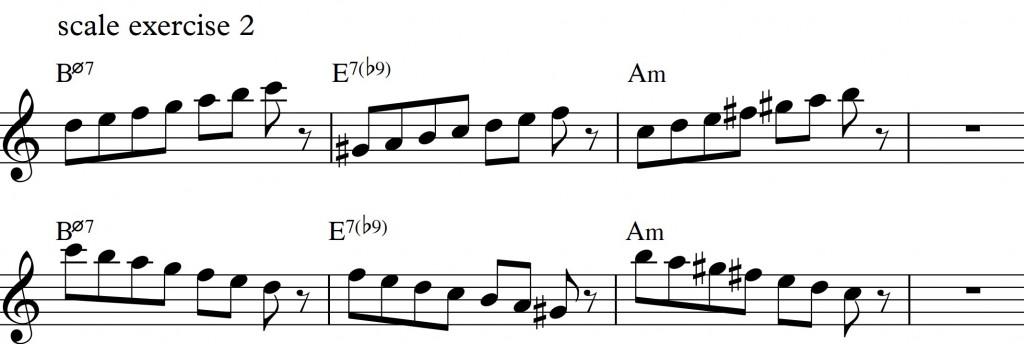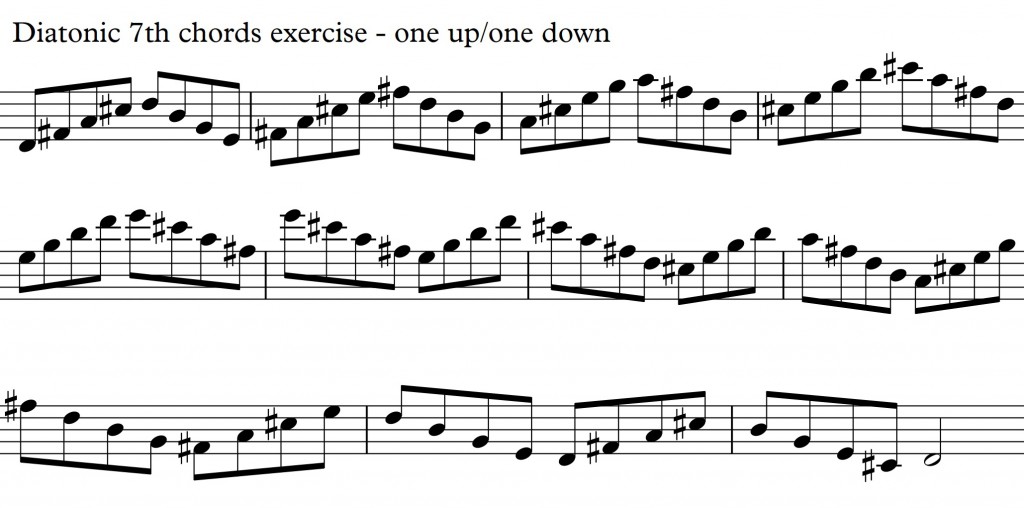In this video I get around the minor II-V-I in minor and explains how you can use the diatonic triads when you improvise. Eø7 – A7(b9) – Dm6.
I call the Dm6, by this name for this lesson but you can also call the tonic minor chord minor-major Dm(maj7), both are good but refers to the extensions of the chord.
The problem mostly found with the minor II-V-I is that you need three different scales to play diatonic over the progression.
The scale of the Eø7 is basically the Fmajor scale played from the E.
E F G A Bb C D E F
The A7(b9) scale is a D harmonic minor scale played from the A
A Bb C# D E F G A Bb
The scale I use over the Dm6 chord is D melodic minor
D E F G A B C#
I will now go on to the chord tones and focus on the diatonic triads in the chords.
The first exercise is the triads of the Eø7 – A7(b9) and the Dm6 in one exercise going through all the different diatonic triads found in the chords.
I put a little rest in there to also adress the rhythmical aspect of exercises. To make exercises not only finger technicalities.
The next exercise is an exercise without the breaks in it, this makes it more phisically demanding and also covers more material in shorter time, further it will adress the ability to think longer 8th note lines.

With these exercises I work with every chord for two bars. Two bars Eø7, two bars A7(b9) and four bars of Dm6. This is an outstretched II-V-I with double the amount of time on each chord. I have chosen to do this to extend the time on each chord.
I recommend that you of course use the above mentioned patterns but definitely also look for your own patterns to get really into the material. One of these methods are finding and developing own musical/technical patterns.
I will go on with som examples of the minor II-V-I which I made consisting of the scale material and the diatonic triads I have explained above.

I start this example going down the Bb major triad ending on a low E going up the Eø7 scale from the G to resolve to the C# on the A7(b9). Going up an inversion of the Bb diminished triad approaching the A with the notes Bb and G, going down the A augmented triad to the low A, resolving to the mid E on the Dm6 chord, which is an approach of the D through the E and the C#. From the D I go up the scale to the F jumping down to an A triad going up to the high A running down the scale and ending on the 9th an E.
Example 2.

I start the exercise with two combined triads, the one of Ediminished and the Dminor triad running up to the high G going donw the Ediminished triad in an inversion to the low G going on to the A of the A7(b9), jumipng up an octave to the high A approaching the F with the notes E-G. The F resloves to the E of an A triad going down ending on the low A jumping up to the high F of the Dm6 the third. Through the F, C#, E and the C# again im approaching the D minor triad played in a triplet figure up, continuing the rest of the example in triplets, approaching the A with the notes B and g, ending on C#,the maj7, high E, the 9th and finally ending on the B – the 6th.
Example 3.

I go down the Dminor triad, A F D, 11, 9, 7 of the Eø7, approaching with the D and the D the E, root of the Eø7, going down the Eo triad to the low E. Begin on an A of the A7(b9) jumping up to the Bb, flat9, approaching the G through the F and the A, picking up from under the Bb and the C#, b9+3 of the A7(b9), jumoing ip to the A, approaching on the Dm6 the F with the G as approach note. Using from the F, the third degree, the A augmented triad approaching the B, the 6th of the Dm6, with the C# + A, jumping up to the E going down the A triad. Approaching the F on the second bar Dm6 with the G+E, ending on some big jumps, A – E – B to C#.
I really hope you enjoyed the approach and the examples.






































